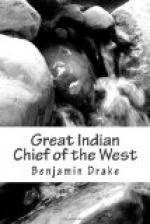The white immigrants continued to increase, and the Sac village was the great point of attraction to them. It was situated on the neck of land formed by the junction of Rock river with the Mississippi, and had been the chief village of the tribe for sixty or seventy years. “Their women had broken the surface of the surrounding prairie with their hoes, and enclosed with a kind of flimsy pole fence, many fields, which were annually cultivated by them, in the raising of corn, beans, potatoes and squashes. They had also erected several hundred houses of various dimensions, some probably an hundred feet in length by forty or fifty broad; which were constructed of poles and forks, arranged so as to form a kind of frame, which was then enclosed with the bark of trees, which, being peeled off and dried under a weight for the purpose of keeping it expanded, was afterwards confined to the walls and roof by means of cords, composed of the bark of other trees. This indeed is a delightful spot:—on the north-west rolls the majestic Mississippi, while the dark forests which clothe the numerous islands of Rock river, with its several rippling streams on the south-east, form a delightful contrast, which is rendered still more pleasing from the general declivity of the surrounding country, as it sinks gradually away to the shores of these rivers. This ancient village had literally become the grave-yard of the nation. Scarcely an individual could be found in the whole nation, who had not deposited the remains of some relative, in or near to this place. Thither the mother, with mournful and melancholy step,




